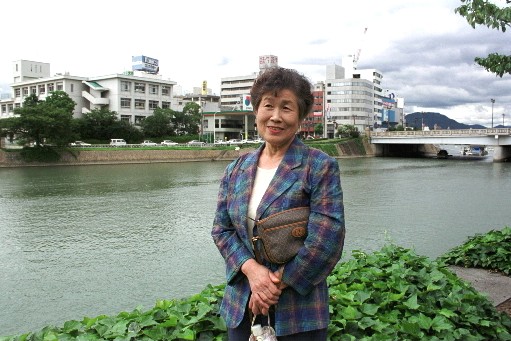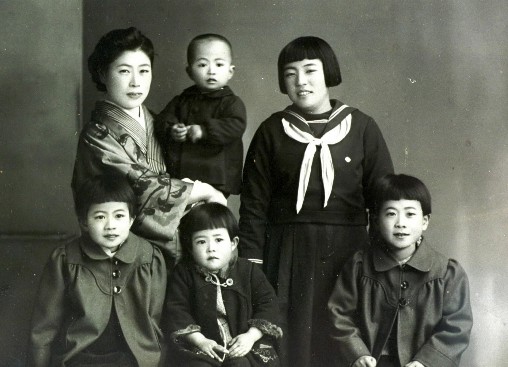Memories of Nakajima Honmachi, Part 1: Ten loved ones lost to the atomic bombing
Jul. 28, 1999
by Masami Nishimoto, Senior Staff Writer
Hiroshima Peace Memorial Park was constructed from the ashes of the first atomic bomb in history to be used against human beings. The impetus for creating the park, the Hiroshima Peace Memorial City Construction Law, was enacted on August 6, 1949. In the park, among the gathering of trees, stand monuments of different size. Residents of the city relax here and visitors from Japan and overseas converge at this site. Behind the peaceful setting, though, rests the memory of Nakajima Honmachi, a neighborhood lost to the atomic bomb. I walked the park grounds with some former residents of the neighborhood who remember the area well. They were born here and lost loved ones in the city. For them, the park is a symbol of both life and death.
“This road in Peace Park used to run straight from the Aioi Bridge. My house was around there,” said Kyoko Takeda, 64, with a slight sigh as she stood before the site of her parents’ house in Nakajima Honmachi, which faced the left bank of the Honkawa River. Only her old school, Honkawa Elementary School on the opposite bank, still stands.
“I just remember digging in the ground and chasing flies away with my hands. I ended up unearthing some dishes,” Ms. Takeda said, smiling as if putting distance between herself and her memories. “After the bombing, I went mad. I lost my entire family.” She was ten at the time.
The fifth grade girls of Honkawa Elementary School had been evacuated from the city. According to school records, 205 children, including 79 girls, from the third grade and above, were evacuated from Hiroshima on April 15, 1945. They were divided into four groups and stayed at different temples in the area now known as Miyoshi, north of the city. Across Hiroshima, the number of children who were evacuated during the war totaled 8365.
“On the train, we felt as if were going on a school trip,” Ms. Takeda said. “But the next day, nobody spoke.” The meals that were intended to distract their minds from loneliness consisted of boiled barley mixed with a bit of rice and fried soybeans. Ms. Takeda laughed, recalling that she was so hungry she nibbled at some stomach medicine she had brought with her.
When Ms. Takeda had the chance to see her family, an event she had eagerly looked forward to, her father Yoshiaki, 37, and mother Fujie, 33, and her mother’s sister Hisako Takagi, 17, came to see her bearing rice balls coated with red-bean paste. “My teacher scolded me because I had three visitors while others had only one,” she said.
And then, as I sat with Ms. Takeda at a coffee shop near Peace Park, she abruptly broke down in tears. “After the bombing, the teacher apologized to me. She told me: ‘I’m sorry that was the last time you could see your family.’ Even though it was a government order for us to evacuate out of the city, I wish I had stayed and perished with them. I still feel that way,” she said.
Ms. Takeda is the only survivor among her family of eight. Right after the bombing, her grandfather, her mother’s father, came to her side. He lost every member of his immediate family, too. He took care of Ms. Takeda, serving as her foster parent, until she married at the age of 21. She began working as a dressmaker and was at his bedside when he died in 1980.
“I cannot feel satisfied with the law because it doesn’t help someone like me who lost so many family members and relatives,” said Ms. Takeda, referring to the Atomic Bomb Survivor’s Relief Law. The law enables those in possession of the Atomic Bomb Survivor’s Certificate to receive financial assistance from the government. Ms. Takeda has not been able to obtain this certificate, though, because she has no witnesses to attest that she was exposed to the bomb’s residual radiation upon entering the lifeless neighborhood to search for the remains of her loved ones.
The cruelty of the atomic bombing is felt very differently by those who actually experienced it and those who simply hear accounts of this experience. Ms. Takeda finally spoke about her experience because I asked, but she has no intention of continuing to talk about it with others, including her grandchildren. “I can’t cry in front of them,” she said with a smile, yet her eyes were wet with tears. “I want to be a cheerful grandmother.”
On August 6, the anniversary of the bombing, Ms. Takeda will visit the Motoyasu River with her grandchildren. Along the river, which runs by the site of her old neighborhood, they will pray and place two lanterns in the water, one with the name Takeda, her own family’s name, and Takagi, the family name of her grandfather. Ms. Takeda’s oldest grandchild is now a third-grader.
(Originally published on July 28, 1999)
Hiroshima Peace Memorial Park was constructed from the ashes of the first atomic bomb in history to be used against human beings. The impetus for creating the park, the Hiroshima Peace Memorial City Construction Law, was enacted on August 6, 1949. In the park, among the gathering of trees, stand monuments of different size. Residents of the city relax here and visitors from Japan and overseas converge at this site. Behind the peaceful setting, though, rests the memory of Nakajima Honmachi, a neighborhood lost to the atomic bomb. I walked the park grounds with some former residents of the neighborhood who remember the area well. They were born here and lost loved ones in the city. For them, the park is a symbol of both life and death.
“This road in Peace Park used to run straight from the Aioi Bridge. My house was around there,” said Kyoko Takeda, 64, with a slight sigh as she stood before the site of her parents’ house in Nakajima Honmachi, which faced the left bank of the Honkawa River. Only her old school, Honkawa Elementary School on the opposite bank, still stands.
“I just remember digging in the ground and chasing flies away with my hands. I ended up unearthing some dishes,” Ms. Takeda said, smiling as if putting distance between herself and her memories. “After the bombing, I went mad. I lost my entire family.” She was ten at the time.
The fifth grade girls of Honkawa Elementary School had been evacuated from the city. According to school records, 205 children, including 79 girls, from the third grade and above, were evacuated from Hiroshima on April 15, 1945. They were divided into four groups and stayed at different temples in the area now known as Miyoshi, north of the city. Across Hiroshima, the number of children who were evacuated during the war totaled 8365.
“On the train, we felt as if were going on a school trip,” Ms. Takeda said. “But the next day, nobody spoke.” The meals that were intended to distract their minds from loneliness consisted of boiled barley mixed with a bit of rice and fried soybeans. Ms. Takeda laughed, recalling that she was so hungry she nibbled at some stomach medicine she had brought with her.
When Ms. Takeda had the chance to see her family, an event she had eagerly looked forward to, her father Yoshiaki, 37, and mother Fujie, 33, and her mother’s sister Hisako Takagi, 17, came to see her bearing rice balls coated with red-bean paste. “My teacher scolded me because I had three visitors while others had only one,” she said.
And then, as I sat with Ms. Takeda at a coffee shop near Peace Park, she abruptly broke down in tears. “After the bombing, the teacher apologized to me. She told me: ‘I’m sorry that was the last time you could see your family.’ Even though it was a government order for us to evacuate out of the city, I wish I had stayed and perished with them. I still feel that way,” she said.
Ms. Takeda is the only survivor among her family of eight. Right after the bombing, her grandfather, her mother’s father, came to her side. He lost every member of his immediate family, too. He took care of Ms. Takeda, serving as her foster parent, until she married at the age of 21. She began working as a dressmaker and was at his bedside when he died in 1980.
“I cannot feel satisfied with the law because it doesn’t help someone like me who lost so many family members and relatives,” said Ms. Takeda, referring to the Atomic Bomb Survivor’s Relief Law. The law enables those in possession of the Atomic Bomb Survivor’s Certificate to receive financial assistance from the government. Ms. Takeda has not been able to obtain this certificate, though, because she has no witnesses to attest that she was exposed to the bomb’s residual radiation upon entering the lifeless neighborhood to search for the remains of her loved ones.
The cruelty of the atomic bombing is felt very differently by those who actually experienced it and those who simply hear accounts of this experience. Ms. Takeda finally spoke about her experience because I asked, but she has no intention of continuing to talk about it with others, including her grandchildren. “I can’t cry in front of them,” she said with a smile, yet her eyes were wet with tears. “I want to be a cheerful grandmother.”
On August 6, the anniversary of the bombing, Ms. Takeda will visit the Motoyasu River with her grandchildren. Along the river, which runs by the site of her old neighborhood, they will pray and place two lanterns in the water, one with the name Takeda, her own family’s name, and Takagi, the family name of her grandfather. Ms. Takeda’s oldest grandchild is now a third-grader.
(Originally published on July 28, 1999)









